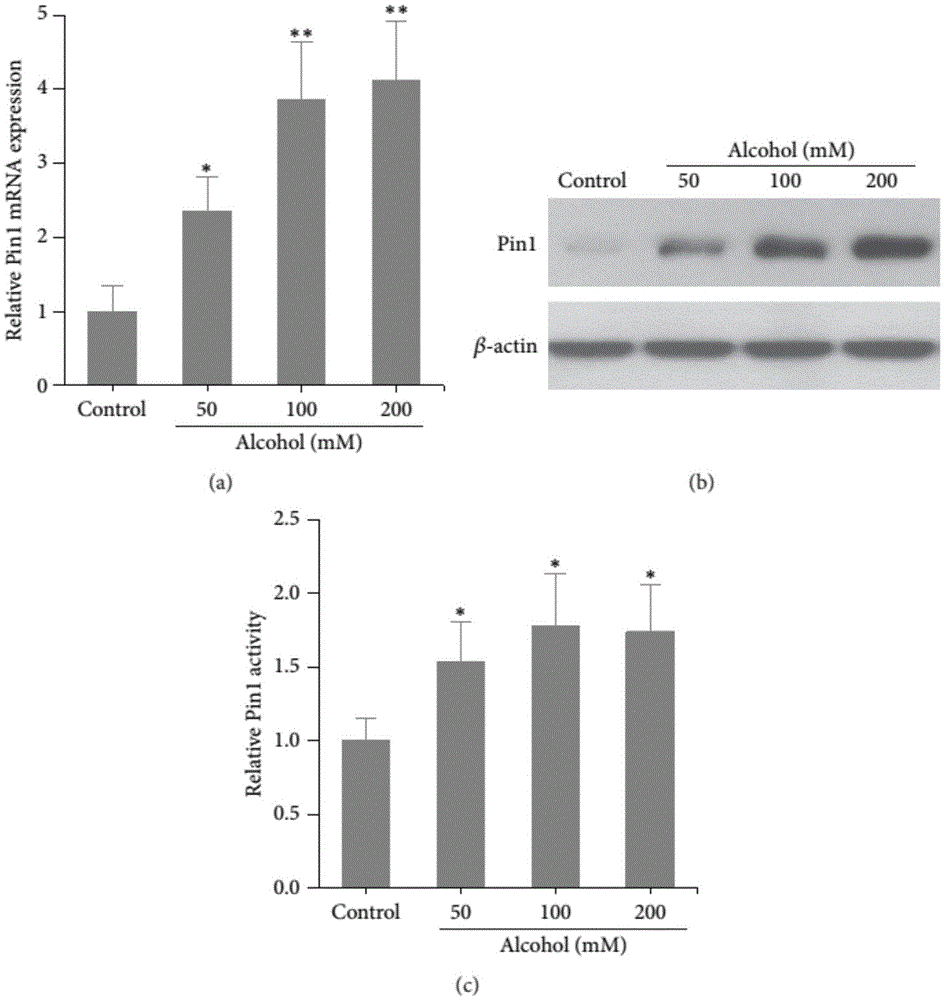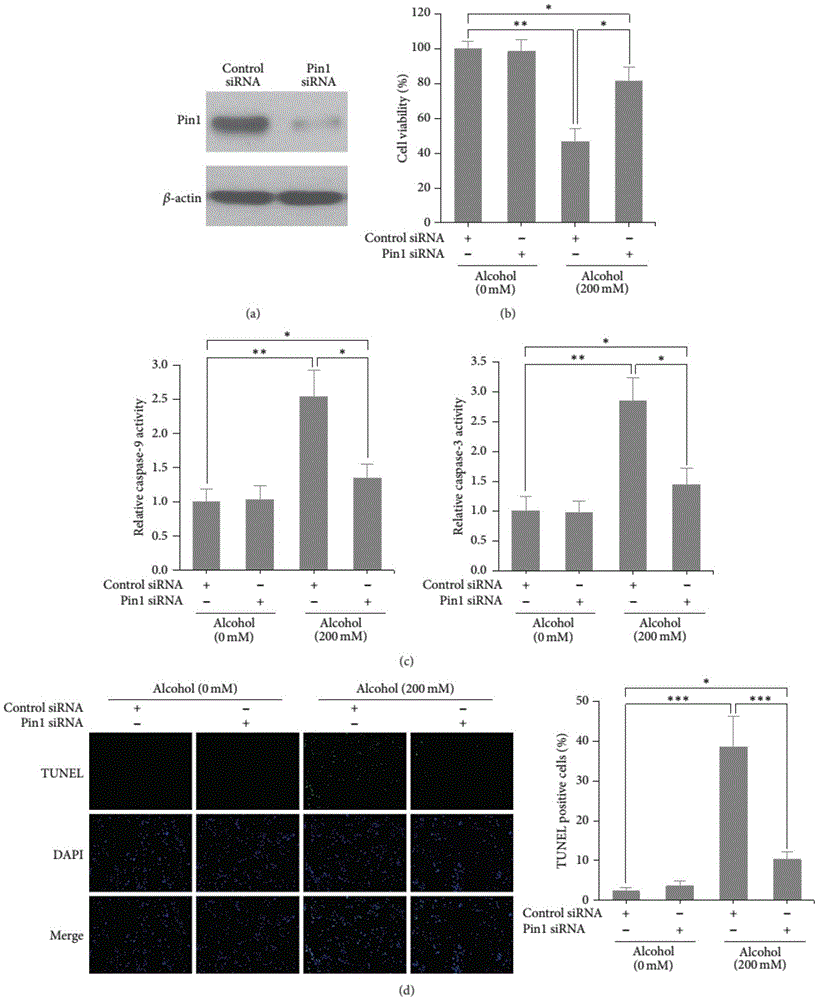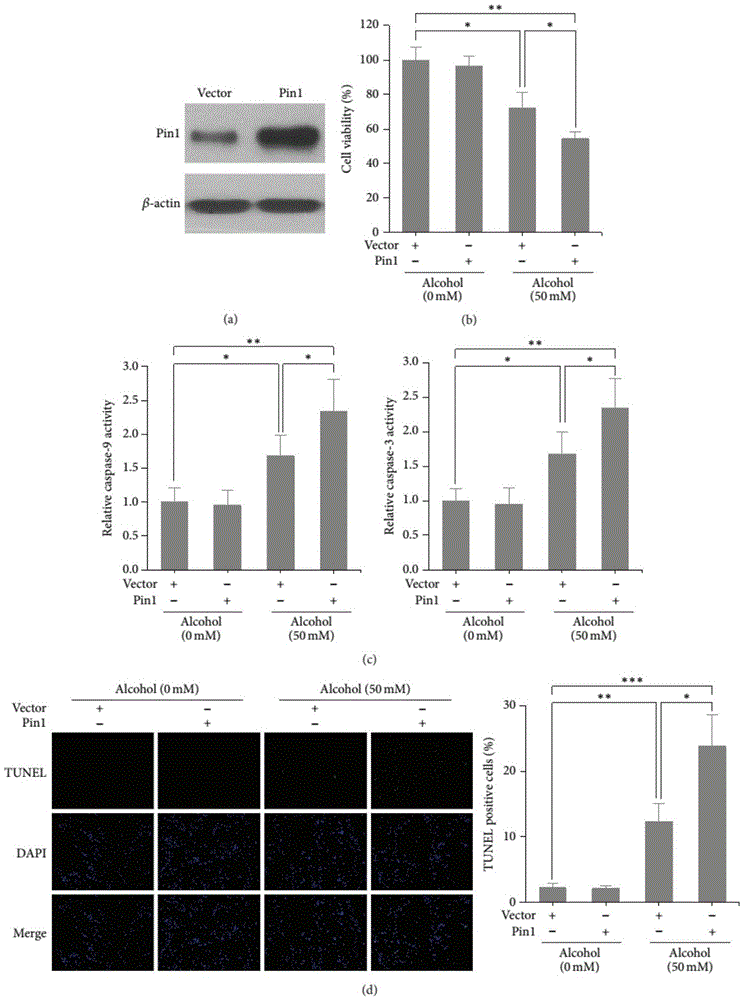Application of Pin1 siRNA in preparation of targeted medicine for treating alcoholic cardiomyopathy
A technology of alcoholic cardiomyopathy and pin1, which is applied in gene therapy, drug combination, cardiovascular system diseases, etc., and can solve problems such as no targeted drugs for alcoholic cardiomyopathy
- Summary
- Abstract
- Description
- Claims
- Application Information
AI Technical Summary
Problems solved by technology
Method used
Image
Examples
Embodiment 1
[0024] Example 1: Expression and activation of Pin1 in alcohol-treated cardiomyocytes
[0025] Firstly, the expression of Pin1 was analyzed after cardiomyocytes were exposed to different concentrations of alcohol (alcohol: 0, 50, 100 or 200 mM). Such as figure 1 a, b, from the results, it can be seen that ethanol can increase the mRNA and protein levels of Pin1 in a dose-dependent manner. In addition, ethanol dose-dependently ( figure 1 c) Increase the activity of Pin1.
Embodiment 2
[0026] Example 2: Pin1siRNA inhibits alcohol-induced cardiomyocyte apoptosis
[0027] method:
[0028] 1. Cell culture and cell transfection
[0029] Cardiomyocytes from neonatal mice were isolated. Heart tissue was minced and digested, sedimented, fibroblasts and endothelial cells were removed, and cardiomyocytes were cultured in collagen-coated culture dishes (approximately 1.5×10 5 cells). Pin1 siRNA (purchased from Invitrogen (Carlsbad)), Pin1 plasmid (purchased from Addgene (Cambridge)) and ScramblesiRNA were transfected using Lipofectamine RNAiMAX (Invitrogen) transfection reagent. Lipofectamine LTX (Invitrogen) was used according to the instructions. Cardiomyocytes (5×10 4 cells / well) were seeded into 24-well plates and grown overnight to approximately 80% confluency. Then the cells were co-cultured with 30 pmol siRNA or 500 ng plasmid for 48 hours, and the transfection efficiency was identified by western blot.
[0030] 2. Quantitative reverse transcription poly...
Embodiment 3
[0049] Example 3: Knockout of Pin1 (Pin1siRNA) reduces alcohol-mediated mitochondrial oxidative stress in cardiomyocytes
[0050] Alcohol-induced apoptosis is dependent on mitochondrial oxidative signaling, and downregulation of Pin1 protects against mitochondrial oxidative stress in diabetic patients. Therefore, we investigated whether Pin1 downregulation could suppress alcohol-induced mitochondrial oxidative stress in cardiomyocytes. In cardiomyocytes with downregulation of Pin1, mCyt.C, mitochondrial membrane potential, and mitochondrial reactive oxygen species (mROS) assays were performed with and without 200 mM alcohol.
[0051] method:
[0052] 1. Measurement of mitochondrial membrane potential
[0053] Mitochondrial membrane potential (Δψm) was assessed using the TMRE Mitochondrial Membrane Potential Assay Kit.
[0054] 2. Determination of mitochondrial cytochrome c release into the cytoplasm
[0055] Cytochrome C release from mitochondria to cytosol was determined ...
PUM
 Login to View More
Login to View More Abstract
Description
Claims
Application Information
 Login to View More
Login to View More - R&D
- Intellectual Property
- Life Sciences
- Materials
- Tech Scout
- Unparalleled Data Quality
- Higher Quality Content
- 60% Fewer Hallucinations
Browse by: Latest US Patents, China's latest patents, Technical Efficacy Thesaurus, Application Domain, Technology Topic, Popular Technical Reports.
© 2025 PatSnap. All rights reserved.Legal|Privacy policy|Modern Slavery Act Transparency Statement|Sitemap|About US| Contact US: help@patsnap.com



